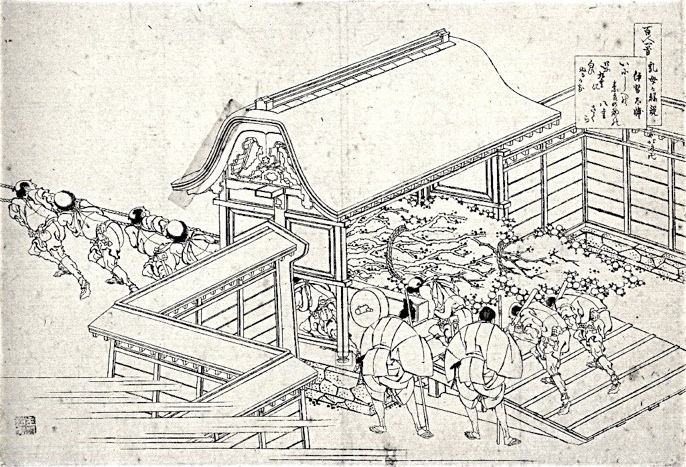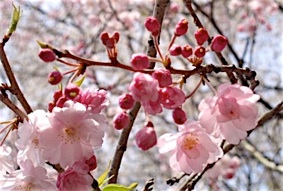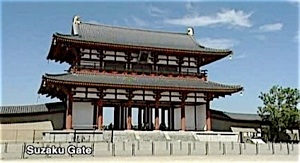伊勢大輔


いにしへの
奈良の都の
八重桜
けふ九重に
匂ひぬるかな
いせのたいふ
いにしへの
ならのみやこの
やえざくら
きょうここのへに
においぬるかな
Lady Ise no Osuke
In ancient times grown
At Nara capital
These eightfold cherry trees
Blossom here and now
And scent this ninefold court.
Hokusai
Ise no Osuke (989? - 1060?), or Ise no Taifu or Tayu, was a granddaughter of Yoshinobu (poem 49). She was lady-in-waiting to empress Shoshi, like Izumi Shikibu (poem 56) and Murasaki Shikibu (poem 57). She belongs to the Thirty-Six Immortal Poets. Fifty-one of her poems are extant.


Yaezakura are
cherry blossoms with more than five petals

In her Collected Poems it is written that she was asked to compose this poem when she accepted a presentation of cherry blossoms at the court. She compares the blossoms coming from trees that grew in the ancient imperial seat of Nara with those that now bloom at this court.
Important elements are the eight petalled cherry blossoms and the ninefold court. Ninefold (kokonoe - ここのえ) refers to the imperial court (ancient palaces had nine gates/walls).
Hokusai shows us the whole cherry tree being laboriously pulled through the imperial gate, which implies that the whole tree was transplanted. Rather drastic.
Nara was the capital of Japan from 710-784. Before this time the imperial palace and capital site was the Fujiwara no Miya ( see poem 2).
Nara Palace was constructed at the north central end of the Nara capital, Heijo-kyo, and occupied an area 1.3 km east-west by 1 km north-south, a total area of 120 hectares. Surrounded by a roofed mud fence, it included the Daigoku-den (where governmental affairs were conducted), the Chodo-in (where formal ceremonies were held), the Dairi (the emperor's residence), offices for various administrative agencies, and a park where parties were held. Since all buildings were constructed of wood, the above-ground structures eventually decayed away; however, the below-ground remains were preserved in good condition. Based on the excavation of the site, which began in 1955, the Suzaku-mon or gate, and the To-in garden could be restored and have been open to the public since 1998. In addition, the excavation continues as an archaeological museum.
Palace site pdf folder.
In 2010 the 1300th anniversary of the Heijo-kyo capital will be celebrated. Watch the video.

Reconstructed entrance gate of Heijo at Nara

Nara’s celebration mascot
This poem was written at the Heian Palace, or the Daidari, which was the original imperial palace of Heian-kyo (present-day Kyoto), the capital of Japan from 794 to 1227. The palace, which served as the imperial residence and the administrative centre of Japan for most of the Heian Period (from 794 to 1185), was located at the north-central location of the city in accordance with the Chinese models used for the design of the capital.
From the mid-Heian period, the palace suffered several fires and other disasters. During reconstructions, emperors and some of the office functions resided outside of the palace. This, along with the general loss of political power of the court, acted to further diminish the importance of the palace as the administrative centre. Finally in 1227 the palace burned down and was never rebuilt. The site was built over so that almost no trace of it remains. Knowledge of the palace is thus based on contemporary literary sources, surviving diagrams and paintings, and limited excavations conducted mainly since the late 1970s. The original site of the palace was where now Nijo Castle can be found. What is left of the original palace is the pond and a small garden at Shinsenen (official site), just south of the Nijo Castle.
Later the imperial palace was relocated to the east of the Daidari palace, and is known as the Kyoto Gosho, or Kyoto Imperial Palace.
A replica of the original palace, the Heian Jingu or Heian shrine, was reconstructed in 1895 for the 1,100th anniversary of the establishment of Heiankyo. It is a Shinto shrine. The main building, or shaden, is designed to imitate the original Heian Imperial Palace on a three-fourth scale. The shrine is dedicated to Emperor Kanmu and Emperor Komei. The former moved the capital to Heiankyo, and the latter was the last before Emperor Meiji moved the capital to Tokyo.
